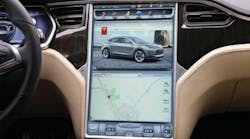Today’s call for high-tech infotainment systems in cars and trucks is spurring new demand for electronic components among automobile manufacturers. Researchers have noted the growing demand for automotive infotainment systems—technology that brings high-tech dashboard displays, Internet radio, and other connectivity solutions to automobiles—over the last few years, and the trend continues as manufacturers focus on new designs and component suppliers seek a bigger piece of the market.
The global connected-car market is expected to reach $132 billion by 2019, growing at a compound annual growth rate of 35% from 2013 to 2019, according to a recent report from research firm Transparency Market Research. The company points to advancements in mobile technology and networks such as 2G, 3G, 4G/long-term evolution (LTE), and Wi-Fi as keys to increasing vehicle connectivity—and making it a must-have among drivers.
“Consumers’ mandates and demands are the primary growth drivers for this market,” the report states. “In addition, rapid growth in network technology, government mandates, essentiality for connectivity, growing awareness about security and safety in-car, and changing consumer preferences for automated systems are critical factors fueling the growth of the global connected-car market.”
Electric vehicle maker Tesla Motors offers a pointed example of just how far the car infotainment market has come—and where it may be headed, according to a recent report from industry researcher IHS Technology. In a teardown analysis of the Tesla Model S, IHS notes that the alternative vehicle maker’s unconventional approach to car design extends to the electronics behind the car’s infotainment and instrumentation system, noting that they have more in common with a tablet or smartphone than with a traditional car.
“The cost structure of the electronics, the use of large displays in the cabin, the touchscreen-based controls, the mobile microchips—everything in this design makes the Tesla experience more like a media tablet or high-end smartphone than a traditional automobile,” Andrew Rassweiler, senior director for materials and cost benchmarking at IHS, said. “It’s like looking at the components from the latest mobile device from an Apple iPad or Samsung Galaxy product. When it comes to the user-facing segment of the Model S’s electronics, the company has radically departed from business-as-usual in the automotive market.”
IHS notes that the most electronics-intensive parts of the Tesla S are the virtual instrument cluster and the premium media control unit—also known as the head unit—which form the main center stack and touchscreen panel. Some of the “outstanding” features, according to the researcher, are:
- A 17-inch display and touchscreen, which is much larger than the average automotive infotainment interface.
- The use of an NVIDIA Corp. Tegra 3, 1.4-gigahertz quad-core processor, providing computing power in the same league with recent smartphone and tablet designs.
- A complex automotive head unit design, with more than 5,000 discrete components.
- A bill of materials (BOM) for the virtual instrument cluster and the premium media control unit that is roughly twice the cost of the highest-end infotainment unit examined by IHS.
Such advances are causing suppliers to step up their attention to the automotive market. As an example, chipmaker Qualcomm’s recent agreement to purchase British chipmaker CSR is a step in that direction, as the company builds its business focused on the Internet of Things. Qualcomm is the world’s largest maker of mobile-phone chips and CSR is a wireless technology solutions provider. With the addition of CSR, Qualcomm will become the world’s fourth-largest supplier of application-specific integrated circuits (ICs) for automotive infotainment, with 10% market share, according to a separate report from IHS. In 2013, the company ranked 11th, with market share of 2.7%.
“Significantly, Qualcomm, through the new acquisition, will attain leadership in the key segment for car wireless application ICs, with a market share of 38 percent,” according to IHS. “Qualcomm already has a strong position in cellular baseband solutions with its Snapdragon and Gobi processors. The California-based company largely dominates this market, with 84% of industry revenue as of last year.”
Other supply-chain companies are responding to the demand as well. Earlier this year, distributor N.F. Smith and Associates pointed to growing automotive-related business as a key driver of its expansion in Europe. Infotainment and security-related business are at the top of the list.
“Automotive component demand is driven by the pent-up demand for new models that are now providing notable upgraded technology in the vehicle as well as improved safety features,” said N.F. Smith’s Mark Bollinger, vice president, marketing. “Both the in-vehicle infotainment … and the improved safety features are driving new car sales.”








